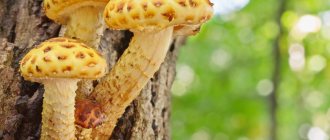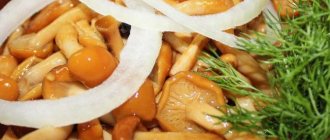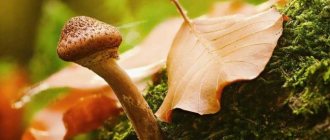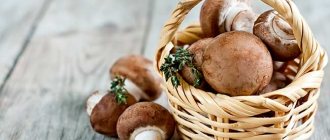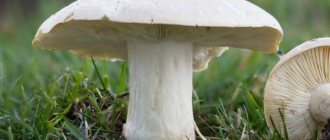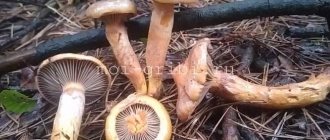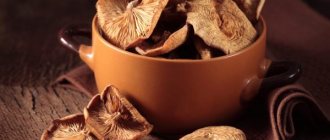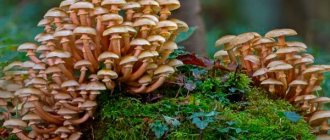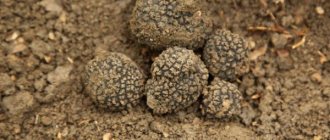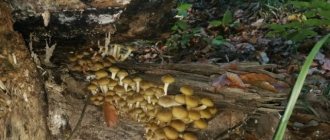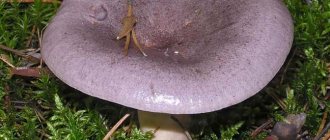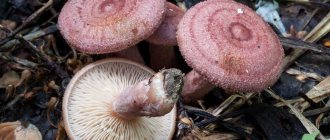One of the most popular mushrooms growing in Russia is the Royal honey mushroom. Due to their attractive appearance, level of usefulness and subtle aroma, they deservedly occupy the 4th category.
People also call this variety “Uspenskaya” and “Golden flake”. The reason for this is the original external data. Each fungus has a cap up to 25 cm in diameter, covered with scales. The color scheme is often dark yellow, close to rusty metal. Less commonly, there are families painted in a dirty golden palette. The stalk may have small red spots or soft spines.
If you are lucky enough to collect a lot of mushrooms from clearing forests and stumps, it is worth learning how to prepare them correctly so that everyone at home is happy. After all, pickled royal mushrooms, like other mushrooms, can be prepared in different ways, depending on taste preferences and the availability of free time. The smaller it is, the fewer cooking options there are.
Below are examples of preparing royal honey mushrooms with a delicious marinade. Each option is interesting in its own way. All that remains is to choose which one is more suitable for preservation for the winter.
Here we are looking at pickling honey mushrooms, and how to salt honey mushrooms is described in our other article.
Where do autumn royal mushrooms grow?
It is worth noting that edible species of royal honey mushrooms grow on damaged tree trunks and old, long-cut stumps.
They can also be found on the ground next to the roots of dead deciduous and coniferous trees. Fruiting of golden scales or royal honey mushrooms begins in August and continues until the end of September. Residents of the Primorsky Territory can collect these amazing mushrooms from mid-May to mid-September. Where else do royal honey mushrooms grow, and which trees are preferred most? Typically, this species of honey mushrooms settles on the trunks of deciduous trees, especially alder or willow; sometimes it chooses birch trees and birch stumps, less often – coniferous trees in wetlands. Look at the photos below showing what royal honey mushrooms look like on trees in the forest:
Sometimes even experienced mushroom pickers, due to the rare appearance of golden scales, confuse them with false honey mushrooms, which grow in the same areas. Therefore, we suggest that you carefully read the photos of edible and false royal honey mushrooms:
As mentioned, scale mushrooms or king mushrooms are edible mushrooms. However, before using it, it must be boiled in salted water for 20-25 minutes. Since royal honey mushrooms have excellent taste, they are used in appetizers, salads, first and second courses. The flakes go especially well with fried or boiled potatoes. In addition, many housewives make preparations for the winter from these mushrooms: pickled, salted, frozen and dried.
Sometimes honey mushrooms can be found in pine forests and spruce forests. What does the royal honey fungus look like if you find it in a coniferous forest? Typically, scales collected in deciduous forests differ from those growing in coniferous forests. The first difference between honey mushrooms found in pine forests is the dark color of the cap and scales, and the second is the bitter taste. However, royal honey mushrooms contain a lot of vitamin C, PP and E. In addition, there are only 22 calories per 100 g of flakes, so the calorie content of this species is very low. That is why they are useful for vegetarians and those who follow a low-calorie diet. In terms of phosphorus and calcium content, royal honey mushrooms even compete with fish.
Experts have classified royal honey mushrooms as category IV of edibility. That is why in other countries they are not eaten or even collected, since this category abroad refers to inedible species. However, in Russia they are prepared in the same way as ordinary autumn mushrooms. They are first boiled in salted water and only then fried, stewed or cooked as first courses. In addition, royal autumn honey mushrooms are used in other culinary recipes: they prepare mushroom stew, julienne, make caviar, pates, sauces, solyankas and mushroom fillings for pizzas and pies.
Although golden flake is widespread in Russia and is well recognized, it is not collected so often. This may be due to the fact that this type of mushroom is not familiar to many people. However, real connoisseurs of mushroom delicacies put it on a par with autumn honey mushrooms and even boletus mushrooms. We invite you to watch a video of royal honey mushrooms being collected in deciduous forests by lovers of “silent hunting”:
Emergency care for mushroom poisoning
- Gastric lavage. At home, you should drink water and induce vomiting by pressing on the root of the tongue. In a hospital, this procedure is carried out using a probe.
- Cleansing enema. It is given if more than two hours have passed since the poisoning.
- Reception of adsorbents. Activated carbon, Enterosgel and other drugs will help bind toxins and neutralize them.
- Drinking salted water or drugs whose action is aimed at combating dehydration. Drink water in small sips, often. The drugs are taken according to the instructions. When the vomiting stops, the patient can be given strong, sweet tea.
- Wrapping up. The victim must be warmed up. Hypothermia may occur due to severe dehydration. Warm blankets, heating pads and complete rest are the first things to do when vomiting and diarrhea stop.
Recipes for golden flake dishes
Before preparing the main course, royal honey mushrooms require preliminary cooking. The stems are cut off almost completely, then the mushrooms are soaked for at least 20 minutes to completely remove debris and insects that have gotten into the plates. Then they are boiled in salted water and placed in a colander to drain excess moisture. It is believed that when pre-cooking, it is necessary to put an onion in the pan: if it darkens, then poisonous honey fungus has become “stuck” among the mushrooms. Unfortunately, it is impossible to identify a poisonous individual in this way. Golden flake recipes:
- Pickled honey mushrooms
. The prepared mushrooms are boiled 2 more times for 20 minutes, each time rinsing with running water and adding new water. The jars are sterilized along with the lids, and at this time the marinade is boiled. Proportions: 1 kg of mushrooms, clean water - 600 ml, salt - 2 tablespoons, the same amount of sugar, 12 black peppercorns, 5 bay leaves and 9% vinegar - 2 tablespoons. Boil the marinade for 5 minutes, add 3-4 crushed large cloves of garlic, boil for another 2 minutes. Transfer the mushrooms into jars, pour boiling marinade over them and screw on the lids. The preserved food is left to cool upside down, under a blanket. - Golden flake in sour cream
. Place 1 kg of pre-prepared mushrooms in a colander or paper towels to remove remaining moisture, cut a large onion into rings and fry it in vegetable oil until golden brown. Lay out the mushrooms, fry for 15 minutes, pour half a glass of fatty, preferably country, sour cream into the frying pan, and simmer for 30 minutes. Then sprinkle the roast with chopped herbs - dill and parsley, close the lid and let the dish brew for at least 15 minutes. Serve with fried or boiled potatoes. - Chicken soup with honey mushrooms
. Honey mushrooms are prepared in the usual way, boiling for at least 20 minutes. Finely chop the onions and carrots - it is more convenient to use a blender, since grating the onions will sting your eyes too much. Potatoes are cut into small cubes. It is advisable to finely chop and boil the chicken meat: place the chicken in boiling water, add a whole onion to the container, and boil for 15 minutes. At this time, fry the onion-carrot mixture in a frying pan with sunflower oil, add mushrooms and also fry for 15 minutes. Remove the onion from the chicken broth, add potatoes, fry completely and cook until done. To improve the taste, use bay leaf, black and allspice peppers, and salt. It is better to sprinkle the soup already poured into bowls with herbs. - Royal honey mushrooms in a slow cooker
. In a modern multi-cooker pan, you can pre-cook royal honey mushrooms and prepare the main dish. Place the washed mushrooms in a bowl, set to stew for 30 minutes, and then place on a steamer. While the liquid is draining, chop the onions and carrots. Heat the bowl on the “fry” mode and pour all the ingredients into it together. You can try the dish after 40 minutes - salt, pepper and add herbs to taste. - Salad with golden flakes
. Boiled chicken fillet is marinated in soy sauce. Boil the potatoes, cut into cubes, cut the carrots. The pickled mushrooms are washed and cut into equal pieces. Mix potato cubes with carrots, mushrooms and fillet pieces. A large onion is cut into rings, each ring is rolled in flour, fried until golden brown, the parsley is washed and torn by hand. The salad is decorated with fried onion rings and parsley sprigs. - Diet puree soup
. The potatoes are cut, boiled until half cooked, the onions and carrots are sautéed in a frying pan with a minimum amount of sunflower oil. Pre-prepared honey mushrooms are fried together with onions and carrots for 20-25 minutes under a lid. The potatoes are taken out of the water - the broth is not poured out, they are combined with the frying, and crushed with a blender. Bring the water to a boil, add the ground mass into it, mix well and leave to infuse under the lid, pouring in half a glass of heavy cream. Salt to taste, add herbs to each plate.
Golden flakes can be used to prepare filling for pies or add to casseroles. Mushrooms are prepared for the winter not only by pickling, but also by freezing. Pre-treatment of thawed mushrooms is carried out in the same way as fresh ones.
Flakes fried with sour cream
When fried, mushrooms turn out porous and meaty. To enhance their taste, sour cream is added to the composition.
You will need:
- boiled edible flake – 800 g;
- pepper;
- vegetable oil – 40 ml;
- onion – 350 g;
- salt;
- sour cream – 250 ml.
How to cook:
- Place mushrooms in a frying pan. Fry without closing the lid until the moisture evaporates.
- Cut the onions into half rings. Pour into the pan. Pour in the oil. Add some salt. Cook over medium heat, stirring constantly, until the vegetable is golden brown.
- Pour in sour cream. Mix. Sprinkle with pepper. Cook for seven minutes.
Advice! To make the taste of the dish more delicate, vegetable oil can be replaced with butter.
SCALE OR PHOLIOTA SQUARROSA
This is one of the most common foliots in the genus, otherwise they are called dry, scaly, fleecy. They grow mainly on wood.
SCALE OR PHOLIOTA SQUARROSA
The veil, which we are accustomed to seeing on the folio of this species, is characteristic mainly of newly grown specimens, which later forms a distinctive skirt on their stem and looks like fleecy scales on the edge of the cap.
External description: sometimes mature mushrooms reach a cap diameter of 20 cm, but for the most part the diameter of this representative is 5–12 cm. Mature mushrooms have a hemispherical or conical cap, then it becomes flat-convex or protruding (highly convex) in shape. The slimy surface has bright yellow dry scales. They taste bitter, but are edible. When broken, the pulp has a whitish or yellowish color.
Key Features
The cap is golden in color and sometimes reaches large sizes. It can be approximately 20 cm in diameter. The mushroom received its proper name due to the dark scales that form on the surface of the cap . Other characteristics:
- The leg has a diameter of up to 2 cm and is also covered with scales. Its length can be 15 cm.
- The mushroom has round and light flesh; after damage, its color does not change. It can be quite dark near the base.
Edible scales prefer mixed and deciduous forests. The fruits of the mycelium are located solitary. It is impossible to meet them in groups. The fruiting season begins in mid-July and can last until the onset of the first cold weather. In October you can still find mushrooms, which are often confused with honey mushrooms of the corresponding shade.
Types of flakes
The genus of scales has about 150 species, of which about 30 grow in the forests of Russia. The most common types are foliots: ordinary, golden, fiery, cinder, alder, gum-bearing, destructive, edible (hint).
Common scalyfoot
This is the most common type. Mushrooms of this type are also called fleecy, scaly, dry. They grow in colonies on the wood of living and rotten deciduous trees. The caps have a diameter of 6-10 cm; in young ones they are hemispherical in shape, in mature ones they are flat. The surface of the caps is pale yellow with pronounced orange-brown scales.
The leg is cylindrical, dense, rusty in color. Young specimens have a veil that breaks when ripe, forming a ring on their stem and flakes along the edges of the cap.
The pulp of this species is fleshy, white or yellow in color, although edible, it tastes bitter.
Golden scale (royal honey mushrooms)
The golden species is one of the largest representatives of foliots: the diameter of the cap can reach 18 cm. Their fruiting bodies are painted in a bright yellow, golden color. The surface of the cap is covered with mucus and small dark brown scales. In young specimens, the cap has a hemispherical shape with tucked edges; in adulthood, it has a saucer shape with a convex center.
Fire scale
This is an inedible species of foliot. Mushrooms of this species are smaller in size than ordinary or golden ones: the diameter of the caps does not exceed 7 cm. The caps are painted in reddish tones and covered with thick curled scales of a lighter color than the cap. The scales on the cap form a pattern of ovals. The pulp is fleshy, hard, yellow in color, becomes brown when broken, has an astringent bitter taste and an unpleasant odor, so it is not eaten. They bear fruit from mid-July to the end of September.
Cinder flake
Cinder flake is also called coal-loving. The caps of this species of mushrooms are often stained with soot and dirt, since their favorite places to grow are burnt trees and fireplaces. Soot, dust and dirt stick to the mucous surface of the caps, so the mushrooms quickly become dirty yellow or dirty brown. In young foliots, the caps are covered with a private veil; in mature ones, the remains of this veil are preserved in the form of a ring on the stem and along the edges of the cap. The legs are covered with small reddish scales. The pulp of these foliots is dense, hard, light yellow, and has no specific taste or smell. There is no information in the literature about the edibility of these mushrooms. They grow from August to October.
Alder scale
These foliots are also called alder moth. They are often found on stumps and alder or birch wood. The size of the firefly caps is small: does not exceed 5-6 cm. The color of the caps is yellow-orange, along their edge there are flake-like remains of a private blanket. The legs are curved and have a pronounced ring. Below the rings are fibrous, above the rings are smooth.
The pulp of the mushrooms is yellowish, dirty yellow, inedible. If eaten, moths can cause poisoning. They bear fruit in August-September.
Gum scale
These mushrooms are also called yellow-green because their fruiting bodies, covered with scales, range in color from light yellow to yellow-green. The diameter of the caps of gum-bearing foliots is 3-6 cm. The pulp is edible because it does not have the rare taste and smell specific to flakes.
Destroying scale
These mushrooms are often found on old and dry poplars, so their second name is foliota poplar or poplar. These fungi actively destroy the wood of the tree during their growth. The caps can reach 20 cm, are colored light brown or yellowish, and covered with white scales. The legs are thinned towards the apex and have swellings at the base. The legs match the caps in color and are also covered with scales.
Edible scale
This type of foliot is industrial. Mushrooms of this species are cultivated on a large scale in Japan and China. Their second name is foliota or nameko honey fungus. Grown in rooms with high humidity - 90-95%. They grow in groups. The sizes of these mushrooms are small - no more than 2 cm in diameter. The color of the fruiting bodies is orange-brown, the surface is covered with thick, dense jelly-like mucus.
They have soft flesh, similar in taste and smell to real honey mushrooms. On the shelves of our stores you can often find pickled edible flakes made in China. Only the inscription on the jar says that it is honey mushrooms (the second name for edible scales). Pickled foliots differ from real honey mushrooms by their mucous marinade, which is due to the jelly-like coating of the caps of the latter.
Useful Features
The edible scale has a fruiting body, in which a small round cap and a low stalk are distinguished. The top is orange in color and covered with a small layer of mucus. It grows both in artificially created conditions and in the wild.
The Japanese use it in their national cuisine. The golden scale has a cap 20 cm in diameter, which in young specimens is distinguished by slightly upward-curved edges. It has a tubercle in the center. Its color can vary from yellow to brown. The top is dense in structure. The hat becomes slippery at high humidity. In dry weather it has a shiny surface and leaks.
Unripe fruits have flesh that is quite dense in structure and yellow in color. The stem is strong and does not exceed 15 cm in height. Common scaly mushroom belongs to the category of conditionally edible mushrooms. This is the most common and popular type. It is bred by Japanese farmers for sale.
Royal honey mushrooms or golden scale mushrooms are category IV mushrooms, which are one of the most common species in Russia. This type of mushroom differs from ordinary honey mushrooms in size, color and the presence of scales. The size of the cap of the fruiting bodies is truly royal - from 10 to 22 cm in diameter. Its color ranges from rusty yellow to dirty gold. The entire surface of the cap and stalk is densely covered with red or brown scales resembling flakes or thorns.
Golden scales, like ordinary honey mushrooms, are found on stumps, dead trees and branches. Royal honey mushrooms also grow in whole families, which makes the work of the mushroom picker easier when harvesting these fruiting bodies.
Gallery: varieties of flakes (47 photos)
Edible scale
Phol.nameko is a variety also known as Honey mushroom nameko, which is translated into Russian as “slippery mushroom.” It grows similarly to honey mushrooms, in whole “families”. From a single base, several fairly thin legs are formed at once.
The edible variety prefers stumps and fallen tree trunks of such not very common broad-leaved species as beech and hornbeam. The cap part is small in size, orange-brown in color, covered with slippery and jelly-like skin. It is cultivated under artificial conditions in Japan and China, where it is widely used to prepare the popular and healthy miso soup.
Edible scale
Common scalyfoot
Phol.squarrosa is a widespread parasitic edible species in our country or a classic saprotroph that develops fruiting bodies on living and dead deciduous wood. It has a flat-convex, convex-conical or hemispherical cap part with folded edges and remnants of a cover. The skin is distinguished by the presence of dry bright yellow scales, mucous type, yellow-red-orange coloring.
The soft part is light beige-yellow or greenish, with an unexpressed earthy aroma and rare taste. The plates are of an adherent type, with a frequent arrangement, yellowish or rusty-brown in color. The leg is whitish with a reddish-reddish-brown tint and the presence of a fibrous and drooping ring. The spores are rusty-reddish-brown.
Common scalyfoot
Hairy scale
Pholiota squarros is an edible variety, distinguished by a yellow or yellowish-red-brown cap with a mass of reddish-brown scales, bell-shaped or semi-prostrate in shape, with the cap edges tucked inward. The soft part is yellowish in color, bitterish, with the taste of garden radish and a pungent odor.
The plates are light yellowish or grayish-brown, growing to the stem or slightly descending. The spores are rusty-red-brown or brown. The leg is monochromatic with a cap, with a ring, covered with scales. It bears fruit from mid-August until late autumn, forming numerous fruiting bodies on stumps and on the trunk of trees.
Hairy scale
Golden scale
Phol.aurivella is a species also known as golden-yellow or grey-yellow scale, willow or royal honey fungus. It has a very characteristic bright golden yellow or golden coloring of the entire fruiting body. The edible species has a large and spherical cap with a glossy surface and the presence of rare brownish scales. Most often, single fruiting bodies are formed on alder or birch stumps in damp and swampy areas.
Golden scale
Poplar scale
Рholiota destruens is a variety also known as poplar. It is distinguished by a hemispherical and fleshy, light brown cap, covered with numerous, but not too large, white scales, reminiscent in appearance of poplar fluff. The husk on the cap is yellowish-brown in color, and the brim has hanging whitish leathery flaps.
Also read: Mushrooms of Belarus: edible, poisonous and spring species
The soft part is whitish, slightly bitter, with a characteristic malt aroma. The plates are often located, fused with the peduncle area, and are whitish, brownish or tobacco brown in color. The spores are yellow or orange. The stalk region is short and thick, thickened and rooted at the base, with a whitish or light brown surface covered with fibrils and having a vanishing ring.
Poplar scale
Fire scale
Phol.flammans is an inedible variety characterized by a bitter taste of the pulp and a not very expressive odor. It has a hemispherical or conical, then convex and flat-convex cap with distinctly folded edges and non-falling remains of the bedspread at the edges. The surface coating is dry, with very visible bright yellow scales.
The soft part is yellowish-orange or brownish in color, with a weak earthy odor, a bland taste and a faint bitter aftertaste. The plates are narrowly incremental, with a frequent arrangement, grayish-yellowish or brownish in color. The leg is dense or hollow, with the presence of a fibrous or membranous ring, covered with bright reddish-yellow or brown scales. The spores are yellowish-brown, oblong, and poorly germinating.
Use in cooking and storage method
Like any mushrooms, honey mushrooms need additional processing. First you need to cut off the entire leg of the honey mushroom, and then soak it in cool water for 20 minutes, but it is better to let them sit longer, this way you will protect yourself and your loved ones. Then the mushrooms need to be boiled. Many people have a question about time, but it’s worth saying right away that it depends directly on your purpose, be it frying, marinating or salting. Any subsequent process requires a different amount of time. Therefore, now we will tell you about each in more detail.
Boiled honey mushrooms
The main thing in cooking mushrooms is time. If there is too little of it, hazardous substances will not be able to evaporate, and if there is too much, then you will simply digest them and all your work will be irrevocably ruined. So, for honey mushrooms the most optimal time is 40-60 minutes.
Cook the mushrooms until they boil, and do not forget to skim the foam all the time. As soon as the water boils, drain it and cook the mushrooms again. Honey mushrooms can be consumed only after the second decoction, so you will be sure that everything harmful came out during cooking. By the way, if you are still tormented by doubts about safety, then the onion will help you, its color is a signal for the hostess. If the bulb darkens, you should not eat mushrooms, as the color indicates that you have come across false honey mushrooms, which are dangerous to your health.
Fried honey mushrooms
Fried mushrooms are a very popular and quick way to cook mushrooms.
Fresh honey mushrooms: First, boil the mushrooms twice for 15 minutes, changing the water each time. Then you can safely fry them until golden brown, adding a couple of cloves of garlic, and at the end sprinkle with herbs. But if you want to amaze your loved ones, then we offer a recipe for royal honey mushrooms with creamy sauce. Any gourmet will like this combination of products, because the smell of mushrooms will be very alluring and appetizing, and the taste will be delicate and refined. Let's start with the sauce, you will need:
- heavy cream 1.5 cups;
- butter – 0.25 cups;
- 100 g hard cheese.
After frying for 15 minutes, pour the cream into the pan and cover with a lid for 10-15 minutes (mandatory, otherwise the cream will separate). After time, sprinkle with grated cheese and serve.
Frozen: you just need to defrost these mushrooms and fry them in oil for about 15 minutes. There is no need to cook them, because, as a rule, mushrooms are frozen after heat treatment.
Mushroom cream soup
Cream soup is a dish of complex preparation and definitely belongs to haute cuisine. Many people think so, but it’s time to dispel this myth and teach housewives to cook it to the delight of others. Anyone with an immersion blender can create this velvety, melt-in-your-mouth masterpiece (without it, you won’t be able to achieve the desired texture of the soup). For cream of mushroom soup for 6-8 servings we need:
- honey mushrooms - 900 g;
- potatoes - 3 pcs.;
- onions - 3 pcs.;
- cream or milk - 3 tbsp;
- butter - 3 tsp;
- salt, pepper - to taste.
First you need to boil the mushrooms, this will take about 30 minutes, but if you use frozen ones, then you just need to defrost and rinse them under water. While the mushrooms are cooking, peel the potatoes, cut them into medium pieces and cook (leave the water, we will need it later). Now, in order not to waste time, finely chop the onion and send it to fry in melted butter until transparent. Place the prepared honey mushrooms with the onion and simmer for about 20 minutes. As soon as the potatoes are cooked, grind them together with the mushrooms in a blender. Now we need water from under the potatoes, add the resulting puree to it and bring it to a boil
Remove the pan from the heat and carefully, stirring all the time, add the cream. Ready!
Pickled honey mushrooms for the winter
In the cold winter, summer and golden autumn are remembered so often that you definitely want to be there. We know that pickled honey mushrooms are a preserve that will not only feed you deliciously, but also warm your soul. For marinating we need:
- honey mushrooms;
- water – 1.5 l;
- allspice – 8 peas;
- garlic – 2 cloves;
- bay leaf – 2 pcs.;
- granulated sugar - 2 tbsp. l.;
- salt and vinegar - 2 tbsp. l. (keep in mind that vinegar is for 1 liter of marinade)
Boil the mushrooms. Pour the second broth into another saucepan, adding finely chopped garlic and all the necessary spices. If you want to give a richer and more unusual taste to the dish, then add spices as you wish. Cook the resulting mixture for about 10 minutes and as soon as it starts to boil, turn off the heat and add vinegar. At this point, you need to add the mushrooms to the marinade and stir them a couple of times. This will help honey mushrooms last longer and not deteriorate during long-term storage in winter. Now all you have to do is wait for the mushrooms to cool down.
The finishing line remains - fill the jars with mushrooms with marinade and close them with lids.
https://youtube.com/watch?v=KKE0itTDITc%3F
Features of preparing pickled mushrooms
Feature 1. – Sterilization
So, as promised, we are writing to you about how to properly sterilize marinade jars, and in general this knowledge will be useful to you for any preparations.
Step 1: Check the jars for defects. It could be the slightest crack, chip - anything. This, albeit minimal, is a source of air and it will ruin your workpiece, on which you spent so much time, effort, and maybe even money.
Step 2. Carefully, using a product, maybe even vinegar and soda, rinse the jars. They must be perfectly clean; this is a very important point.
Step 3. Sterilization. It can be done in different ways.
The first one is the ferry. To do this, you need to boil water in a saucepan and place a flat metal sieve on top that can support the weight of several cans. The jars must be placed upside down on a sieve so that a strong stream of steam flows directly into the jar. The water should boil for 15-20 minutes, this is how long sterilization will take. Then, the finished jars will also need to be placed upside down on a clean towel or any other clean cloth so that the water condenses and removes excess glass.
The second is in the oven. Place the jars, still damp after washing, in the oven and heat it to 160-180 degrees. Keep in the oven until all the water has completely evaporated, then carefully place on a baking rack.
The third is in the microwave. Pour cold water into the bottom of the jars. Just about 1 centimeter. Then, turn on the microwave for 4 minutes (+-1 minute) and wait for the water to evaporate. This is the same as steam sterilization. Just be careful, empty cans should no longer be heated - this is very dangerous. The jars will then also need to be placed upside down on a clean towel so that all the water drains out.
Feature 2. Soaking mushrooms
This step is not written about in every recipe, but this is very in vain, the step is very important. The fact is that mushrooms tend to absorb various dirt and toxins from the soil and air. This feature is not fatal and all the dirt is perfectly absorbed by cold, salted water, but it just needs to be given time to act. So soak for at least a couple of hours. This will also help you get to grips with cleaning mushrooms faster.
Feature 3. Spices
In pickling honey mushrooms there are no strict rules regarding spices, the main thing is salt, sometimes sugar and vinegar. But what herbs or whole spices you use is not so important, and this opens up a lot of room for improvisation. Some people prefer to add bay leaf, garlic or black peppercorns - these are all the most common additives. But many also recommend adding whole cloves, cinnamon, paprika or, for example, whole hot pepper. You can also fry the onion until golden brown and add it. Try it!
The best recipes with royal honey mushrooms
You can prepare delicious and healthy dishes from royal mushrooms. A selection of the three best recipes is the best proof of this.
Royal honey mushrooms with sour cream sauce
This dish includes the following ingredients:
- kilogram of fresh mushrooms;
- one onion;
- half a glass of vegetable oil;
- the same amount of fat sour cream;
- greens, pepper and salt.
Cooking steps:
- Separate the caps from the stems, wash and cut them.
- Cook them in half an hour.
- Place the semi-finished product in a colander and wait a couple of tens of minutes for excess liquid to drain.
- Fry the onion cut into rings.
- Add mushroom preparations to the frying pan and fry them in oil for a quarter of an hour.
- Then pour sour cream into the frying pan and simmer the dish under the lid for several minutes, and at the end add salt and pepper.
- Place on a plate, sprinkle with chopped herbs. It is good served with boiled potatoes.
French cream soup
For 3 servings of a delicate and savory dish you will need:
- four medium-sized potatoes;
- one standard carrot and onion each;
- 12 pieces of fresh or frozen mushrooms;
- one and a half liters of water;
- three high quality processed cheeses;
- vegetable oil and herbs.
Cooking technology:
- Grate the processed cheese on a coarse grater or cut into cubes.
- Peel the vegetables, cut the potatoes into cubes, coarsely chop the carrots, finely sauté the onion.
- Fry carrots and onions in vegetable oil until golden brown.
- Cook the potatoes and mushrooms until half cooked, filling them with water.
- Add salt and processed cheese, and fried carrots and onions.
- Cook everything until done.
- Rub the finished soup through a sieve and after boiling, cook for a few more minutes.
- Serve with croutons, chopped parsley, cilantro and dill.
Pickled honey mushrooms
Pickled honey mushrooms
For home preparation you need to take:
- kilogram of flakes;
- one onion;
- a few peas of allspice, cloves, bay leaf, a little fresh dill;
- a quarter glass of salt.
Cooking sequence:
- Clean and rinse forest products.
- Cook in an enamel bowl for ten minutes in salted water.
- Then drain this liquid, pour new water over the mushrooms and cook for about half an hour until they settle to the bottom.
- Place spices, onions, mushrooms in layers in a clean container and sprinkle them with salt.
- Cover the last layer with a napkin and place pressure on top for a week.
- Then you can eat them by adding finely chopped garlic.
- If desired, the workpiece can be placed in sterile bottles and sealed. And then store in the refrigerator or cellar.
A very simple and quick recipe for pickling honey mushrooms at home
This recipe will allow you to enjoy the taste of mushrooms after 4 hours. An excellent appetizer is suitable for a family dinner and will be the highlight of a fun feast.
For lovers of sour dishes, you can increase the amount of vinegar.
You will need:
- honey mushrooms – 1 kg;
- garlic – 2 cloves;
- salt – 13 g;
- water – 550 ml;
- pepper – 6 peas;
- cloves - 2 stars;
- sugar – 13 g;
- bay leaf – 2 leaves;
- vinegar – 30 ml (6%);
- onion.
Step by step process:
- Sort out the mushrooms. Use only young specimens. Cut off the lower part of the leg.
- Place in a saucepan. To fill with water. Cook for half an hour. Drain the liquid.
- For the marinade, pour all the necessary ingredients into the water. Cook for 12 minutes. Add bay leaf and vinegar. After 2 minutes, remove from heat.
- Place honey mushrooms in a container. Pour over the marinade, add chopped onion and garlic cloves.
- Cover with a lid. Cool. Stir and taste. If there is not enough salt or spices, add.
- Place in the refrigerator for 2 hours.
Interesting Facts
What we call honey fungus is, in fact, only a very small part of the entire huge organism of this fungus. Fruiting bodies are just a method of reproduction, and the rest of the mass of this organism is hidden in the thickness of the earth and wood on which the fungus lives. The honey fungus is the largest and perhaps the oldest organism on our planet. A specimen living in one of the US national parks covers an area of almost 9 kilometers and is over 3 thousand years old (according to other hypotheses, all 7).
Honey fungus is a rather dangerous forest parasite. Where large accumulations of this fungus are noticed, trees begin to die for an apparently incomprehensible reason. In fact, honey mushrooms are to blame for this, as they are able to penetrate the thickness of the wood with hyphae and deprive the tree of nutrients.
